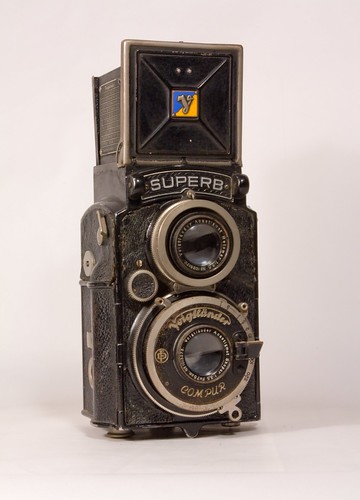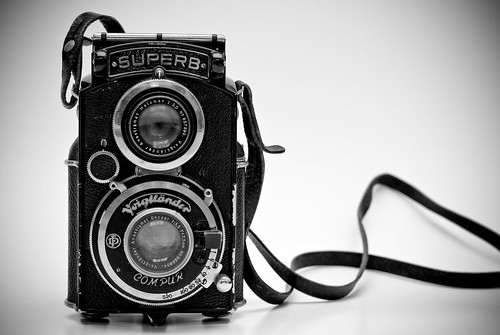Difference between revisions of "Superb"
m (+ refs to two more cameras at Westlicht, and noted that a Heliar could be had.) |
m (+wikilink for Heliar, and -{stub}) |
||
| Line 1: | Line 1: | ||
| − | |||
<div class="floatright plainlinks" style="margin:0px 0px 15px 15px;"> | <div class="floatright plainlinks" style="margin:0px 0px 15px 15px;"> | ||
{{Flickr_image | {{Flickr_image | ||
| Line 12: | Line 11: | ||
The '''Superb''' is a well-engineered but somewhat quirky metal-bodied [[TLR]] for 6x6 cm pictures on 120 roll film, made by [[Voigtländer]]. The camera was introduced in 1933. This was six years after [[Franke & Heidecke]] made the first [[Rolleiflex]]; however, the Rolleiflex is derived from the stereo F&H's [[Heidoscop]], which is itself a copy of Voigtländer's [[Stereflektoskop]], so it is probably unjust to describe the Superb as a copy of the Rolleiflex. This first model of the Superb can be identified by cast-metal strap lugs which extend outwards like ears;<ref name=W1933>[http://www.westlicht-auction.com/index.php?f=popup&id=36854&_ssl=off#36854 1933 Superb] with 7.5 cm f/3.5 Skopar taking lens, Helomar viewing lens and Compur shutter with speeds to 1/250 second, sold at the [http://www.westlicht-auction.com/index.php?id=35247&acat=35247&offset=1&lang=3 May 2005 Westlicht Photographica Auction] in Vienna.</ref><ref>[http://www.liveauctioneers.com/item/1715155 1933 Superb] sold at auction by [http://www.auction-team.de/english/index.htm Auction Team Breker] in Cologne in March 2006.</ref> later models have pressed-metal lugs screwed onto the body,<ref name=W1934a>[http://www.westlicht-auction.com/index.php?f=popup&id=36855&_ssl=off#36855 1934 Superb], also sold at the May 2005 Westlicht auction.</ref> as illustrated here. In the later cameras, the hood is the familiar TLR style, with the front panel folding to form a frame finder.<ref name=EP/><ref name=W>[http://westlicht-auction.com/index.php?f=popup&id=209957&_ssl=off#209957 Superb] serial no. 599627, sold at the [http://westlicht-auction.com/index.php?id=197074&acat=197074&lang=3 December 2010 Westlicht auction]; several excellent photographs of the camera.</ref> According to the notes at ''Early Photography'' though, the hood on the earliest cameras does not fold into a frame finder.<ref name=EP>[http://www.earlyphotography.co.uk/site/entry_C215.html Superb] with Skopar and Helomar lenses and Compur shutter, and notes about the development of the camera, at [http://www.earlyphotography.co.uk/index.html Early Photography].</ref> The focus hood always has a folding magnifier. | The '''Superb''' is a well-engineered but somewhat quirky metal-bodied [[TLR]] for 6x6 cm pictures on 120 roll film, made by [[Voigtländer]]. The camera was introduced in 1933. This was six years after [[Franke & Heidecke]] made the first [[Rolleiflex]]; however, the Rolleiflex is derived from the stereo F&H's [[Heidoscop]], which is itself a copy of Voigtländer's [[Stereflektoskop]], so it is probably unjust to describe the Superb as a copy of the Rolleiflex. This first model of the Superb can be identified by cast-metal strap lugs which extend outwards like ears;<ref name=W1933>[http://www.westlicht-auction.com/index.php?f=popup&id=36854&_ssl=off#36854 1933 Superb] with 7.5 cm f/3.5 Skopar taking lens, Helomar viewing lens and Compur shutter with speeds to 1/250 second, sold at the [http://www.westlicht-auction.com/index.php?id=35247&acat=35247&offset=1&lang=3 May 2005 Westlicht Photographica Auction] in Vienna.</ref><ref>[http://www.liveauctioneers.com/item/1715155 1933 Superb] sold at auction by [http://www.auction-team.de/english/index.htm Auction Team Breker] in Cologne in March 2006.</ref> later models have pressed-metal lugs screwed onto the body,<ref name=W1934a>[http://www.westlicht-auction.com/index.php?f=popup&id=36855&_ssl=off#36855 1934 Superb], also sold at the May 2005 Westlicht auction.</ref> as illustrated here. In the later cameras, the hood is the familiar TLR style, with the front panel folding to form a frame finder.<ref name=EP/><ref name=W>[http://westlicht-auction.com/index.php?f=popup&id=209957&_ssl=off#209957 Superb] serial no. 599627, sold at the [http://westlicht-auction.com/index.php?id=197074&acat=197074&lang=3 December 2010 Westlicht auction]; several excellent photographs of the camera.</ref> According to the notes at ''Early Photography'' though, the hood on the earliest cameras does not fold into a frame finder.<ref name=EP>[http://www.earlyphotography.co.uk/site/entry_C215.html Superb] with Skopar and Helomar lenses and Compur shutter, and notes about the development of the camera, at [http://www.earlyphotography.co.uk/index.html Early Photography].</ref> The focus hood always has a folding magnifier. | ||
| − | The Superb has Voigtländer's own lenses: a 7.5 cm f/3.5 Skopar taking lens (in most examples: a Heliar was also available<ref name=WHeliar>[http://www.westlicht-auction.com/index.php?f=popup&id=102214&_ssl=off#102214 1935 Superb] with 7.5 cm f/3.5 Heliar taking lens, Helomar viewing lens and Compur shutter, sold at the [http://www.westlicht-auction.com/index.php?id=94190&acat=94190&lang=3 November 2007 Westlicht auction].</ref>) and an f/3.5 Helomar viewing lens. It has a Compur shutter with speeds 1 - 1/250 second, plus 'B' and 'T', customised for the camera in that the shutter speeds on the rim are engraved in reverse, so that they read correctly when seen from above in a small mirrored prism, in normal camera use. This can be seen in the lower picture here. | + | The Superb has Voigtländer's own lenses: a 7.5 cm f/3.5 Skopar taking lens (in most examples: a [[Heliar]] was also available<ref name=WHeliar>[http://www.westlicht-auction.com/index.php?f=popup&id=102214&_ssl=off#102214 1935 Superb] with 7.5 cm f/3.5 Heliar taking lens, Helomar viewing lens and Compur shutter, sold at the [http://www.westlicht-auction.com/index.php?id=94190&acat=94190&lang=3 November 2007 Westlicht auction].</ref>) and an f/3.5 Helomar viewing lens. It has a Compur shutter with speeds 1 - 1/250 second, plus 'B' and 'T', customised for the camera in that the shutter speeds on the rim are engraved in reverse, so that they read correctly when seen from above in a small mirrored prism, in normal camera use. This can be seen in the lower picture here. |
The camera is focused by turning the viewing lens, which is coupled by external gearing to a helical thread behind the taking lens (so that the taking lens and shutter move without turning); the gearing can be seen in the lower picture here. The focus scale is around the viewing lens. The viewing lens tilts with the focus, giving automatic parallax-error correction, at least in later cameras.<ref name=EP/> Parallax-error correction is also possible with the frame-finder, by a moving mask for the eyepiece window.<ref name=W/> | The camera is focused by turning the viewing lens, which is coupled by external gearing to a helical thread behind the taking lens (so that the taking lens and shutter move without turning); the gearing can be seen in the lower picture here. The focus scale is around the viewing lens. The viewing lens tilts with the focus, giving automatic parallax-error correction, at least in later cameras.<ref name=EP/> Parallax-error correction is also possible with the frame-finder, by a moving mask for the eyepiece window.<ref name=W/> | ||
Revision as of 17:37, 13 December 2012

|
| Superb image by willboy2010 (Image rights) |
The Superb is a well-engineered but somewhat quirky metal-bodied TLR for 6x6 cm pictures on 120 roll film, made by Voigtländer. The camera was introduced in 1933. This was six years after Franke & Heidecke made the first Rolleiflex; however, the Rolleiflex is derived from the stereo F&H's Heidoscop, which is itself a copy of Voigtländer's Stereflektoskop, so it is probably unjust to describe the Superb as a copy of the Rolleiflex. This first model of the Superb can be identified by cast-metal strap lugs which extend outwards like ears;[1][2] later models have pressed-metal lugs screwed onto the body,[3] as illustrated here. In the later cameras, the hood is the familiar TLR style, with the front panel folding to form a frame finder.[4][5] According to the notes at Early Photography though, the hood on the earliest cameras does not fold into a frame finder.[4] The focus hood always has a folding magnifier.
The Superb has Voigtländer's own lenses: a 7.5 cm f/3.5 Skopar taking lens (in most examples: a Heliar was also available[6]) and an f/3.5 Helomar viewing lens. It has a Compur shutter with speeds 1 - 1/250 second, plus 'B' and 'T', customised for the camera in that the shutter speeds on the rim are engraved in reverse, so that they read correctly when seen from above in a small mirrored prism, in normal camera use. This can be seen in the lower picture here.
The camera is focused by turning the viewing lens, which is coupled by external gearing to a helical thread behind the taking lens (so that the taking lens and shutter move without turning); the gearing can be seen in the lower picture here. The focus scale is around the viewing lens. The viewing lens tilts with the focus, giving automatic parallax-error correction, at least in later cameras.[4] Parallax-error correction is also possible with the frame-finder, by a moving mask for the eyepiece window.[5]
The film passes horizontally across the camera, with an advance lever positioned for the left thumb.[5] There is a frame counter, allowing film advance without using the red window once the film is set to frame 1. However, according to the notes at Early Photography, the film advance does not incorporate 'auto-stop' (i.e. the lever does not lock once the film has advanced a full frame).[4]

|
| 1934 Superb image by Nikita B (Image rights) |
Notes
- ↑ 1933 Superb with 7.5 cm f/3.5 Skopar taking lens, Helomar viewing lens and Compur shutter with speeds to 1/250 second, sold at the May 2005 Westlicht Photographica Auction in Vienna.
- ↑ 1933 Superb sold at auction by Auction Team Breker in Cologne in March 2006.
- ↑ 1934 Superb, also sold at the May 2005 Westlicht auction.
- ↑ 4.0 4.1 4.2 4.3 Superb with Skopar and Helomar lenses and Compur shutter, and notes about the development of the camera, at Early Photography.
- ↑ 5.0 5.1 5.2 Superb serial no. 599627, sold at the December 2010 Westlicht auction; several excellent photographs of the camera.
- ↑ 1935 Superb with 7.5 cm f/3.5 Heliar taking lens, Helomar viewing lens and Compur shutter, sold at the November 2007 Westlicht auction.
| German TLR () | |
|---|---|
| 35 mm | Contaflex | Flexilette | Optima Reflex |
| 3×4 | Pilot Reflex |
| 4×4 | Baby Rolleiflex (1931) | Baby Rolleiflex (1957) | Karma-Flex |
| 6×6 | Altiflex | Amplion Reflex | Brillant | Flektar | Flexo | Flexora | Flexora II | Flexora III | Foth-Flex | Ikoflex 1 | Ikoflex II | Ikoflex Ia | Ikoflex Ic Ikoflex Favorit | Karma-Flex | Mentorett | Montiflex | Peerflekta | Perfekta | Photina Reflex | Plascaflex | Reflecta | Reflekta | Reflekta II | Rica Flex | Rocca Automatic | Rocca Super Reflex | Rolleiflex | Rolleicord | Rollop | Superb | Superflex | Trumpfreflex | Vitaflex | Weltaflex | Wirgin Reflex | Zeca-Flex |
| 6×9 | Superfekta |

|
| Superb showing reverse-engraved shutter speeds which are reflected in the small prism image by Geoff Harrisson (Image rights) |